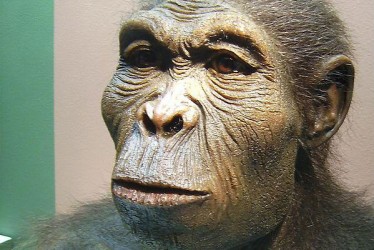130 Minutes, PG-13
Fair Value of Dawn of the Planet of the Apes: $15.00. An inter-apocalyptic film that is the best of this year’s summer blockbuster crop. Dawn of the Planet of the Apes is worth attention because it marks a turning point in the history of cinema and CGI, albeit a dismal one. The age of the actor is gone, all hail the mook in the CGI suit.
Summary: A young female Chimpanzee named Dawn is having all sorts of trouble at her prestigious ape academy. Her father Caesar (Andy Serkis) wants her to go to Harvard, her boyfriend wants to go all the way, and the upper class females in the troop want her to groom them for lice and nits! And to top it all off, there’s a bunch of escaped human slaves that have gotten away from the compound! Luckily, Dawn has her friends- a nerdy Gorilla named Grod, a sassy Orangutan named Clydette, and her adorable Spider Monkey pal Dottie! And she’s about to learn valuable wisdom from her human nanny, Mammy (Dame Judi Dench)!
You’re $@#%ing Me: So very, very much. Now to the actual film:
Ape-Pocalypse Now! There were Planet of the Apes sequels before my parents were even aware of each other. There were Planet of the Apes sequels in my teenage years, and now there are Planet of the Apes sequels in the empty summer of my adulthood. It’s a bittersweet comfort to understand that there will be Planet of the Apes films premiering in the decades after my death, whenever that may be.
That first picture above is not a model of one of the evolved chimpanzees of Dawn of the Planet of the Apes– that’s a reconstructive model of the human ancestor, Homo Habilis. Mankind is an extinction machine, arguably the best biological entity at achieving the total elimination of ecosystems. And our earliest victims were our closest relatives- Homo Austrolopithicus, Homo Habilis, and lastly the Neanderthals. Genocide is inherent to our species, possibly predating even tool use. Possibly there is some vestigial remnant of instinct that thrills at the prospect. And so, we have so many movies chock full of people killing simian-featured orcs and Martians and, of course, apes. Which brings us to this film, the best of the lot since the original Charlton Heston flick.
Since the events of Rise of the Planet of the Apes, humanity has been laid low by a pandemic which has wiped out all but 1 out of every 500 of the hominid population. Caesar (Andy Serkis) has led his band of mutated chimpanzees, gorillas, and orangutans into the Muir woods, north of San Francisco, where they’ve constructed a lovely ewok village and are doing their best to keep a running re-enactment of the lifestyles of the Ohlone people, even though the tourist have stopped coming.
Caesar has the usual problems of a Marin County HOA Chairman- a rebellious teenage son (Kodi Smit-McPhee), a wife who’s not responding well to homeopathic treatments, and dealing with an incredibly non-tolerant and non multicultural underling, Koba (Toby Kebbell). And of course, that’s not even counting the armed and dangerous hoboes who are coming up from the streets of San Francisco, led by a poncho-wearing Malcolm (Jason Clarke). Of course, the dynamic is now chimpanzees resenting humans, rather than anglos resenting latino immigrants, but it’s a familiar scene already.
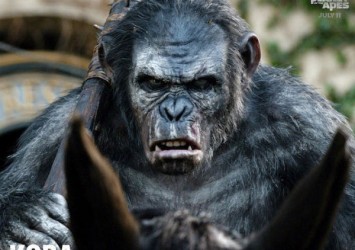
Meanwhile, Commissioner Gordon (Gary Oldman) is trying to restart a hydro-electric dam for the survivors of San Francisco. The problem lays in the fact that Marin County is now ape territory. At this point, I’d like to nit-pick an easy solution: there’s hydroelectric dams south of the Bay Area, like the San Luis dam and the Friant dam. But since that would involve going to Fresno, I can understand Oldman’s preference for brinksmanship with a large tribe of angry monkeys.
The central theme of Dawn of the Planet of the Apes is that while assholes may not always triumph, they will always be present, and they will always do enough to ensure that there will be no lasting peace or understanding between the races.
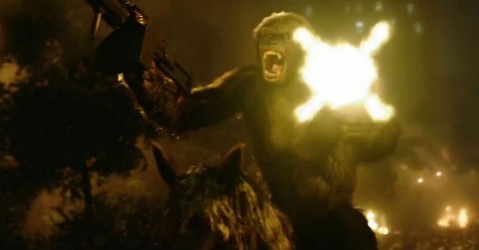
More fun than a barrel of monkeys, specifically the fun of a barrel of monkeys with machine guns:
What makes this rebooted franchise work is that we are no longer dealing with people in rubber masks, but impressively well constructed facial expressive motion capture. These are beings that walk with the posture of chimps but emote with the expressions of men. Good science fiction is frequently those films that take the time to layer empathy for the alien, a virtue where Dawn abounds. The opening scenes involve 10 minutes of communication with barely a spoken sound- of course the apes would rely on signing as their dominant language. Their graceful movement through trees and buildings alike allows them to be credible threats- in the film, they can come at people from any angle.
In this, the Simian appearance works to undercut the phenomenon of the uncanny valley. It achieves a compromise which is wholly effective. We can’t accept the faux humanity of Polar Express or Final Fantasy. But by using hominid faces, namely a more humanized chimpanzee (or h. habilis) face, we get the empathic payoff while also explaining away the deficits in the facial behaviors.
Cloverfield director Matt Reeves has an excellent talent for well composed tracking shots, with absolutely beautiful pans of the advancing primate horde, a battle sequence shot from the perspective of a wildly spinning tank turret, and a taut action sequence in which Malcolm has to navigate through a Market district awash in Gorilla warfare.
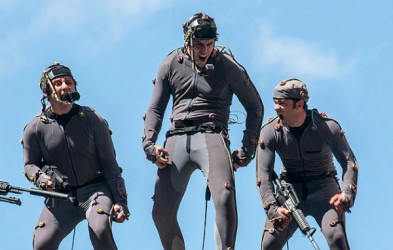
Dawn of the Cinema of the Machines:
Here is the first summer blockbuster where the CGI characters are central to the drama, with humans being rendered into secondary roles. This is why Dawn of the Planet of the Apes is a turning point- it is a mile post of transition, much as The Jazz Singer or Terminator 2, signaling the end of an era. Hollywood is ready to turn out the stars.
Last year, when I review Ari Folman’s breath-taking science fiction meditation on celebrity, The Congress, I thought that Folman and Stanislaw Lem were dealing with a world still decades away- a world where Hollywood no longer had to rely on human actors, but could instead compose and direct characters with no more annoying ad libbing or characterization from those meddling actors. Once again, I find that the future has arrived faster than I had appreciated. Who needs a new starlet, if you’ve negotiated the right to Marilyn Monroe’s likeness, and you can get talent like ILM or Weta to map out a new performance pattern for a dead visage?
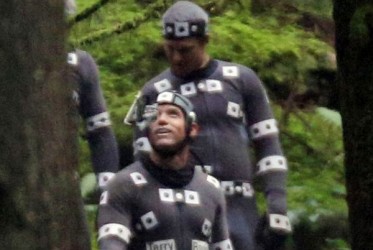
The acting can be left to the graphics houses. As long as you have some patient interns willing to do some pantomime wearing a motion capture suit, you can get the basic movements, and then you can texture the performance after that with a digital effects house.
My point is that this film will not lead to marquee roles for Toby Kebbell or Kodi Smit-McPhee. Andy Serkis is famous and acknowledged for his talent, but that’s mostly because he was the first. We will not know the faces of the leading men and ladies of the future.
So there’s a subtle irony to this hit film, where we are entertained by the howling conquerors, who wear the faces of our ancestors- they actually are our successors. We are going from being replaced in an industrial capacity to being replaced in a creative and intellectual capacity by automation.
It is not like we should miss them, the star actors. They’ve been monsters since the days of Clara Bow. Our celebrity culture shall now go entirely to the veneration of the worthless and untalented, antithesis of meritocracy.
There won’t even be a pretense of a basis for the assignment of fame. But we’ve become a people who can only stomach heroes as frauds, and only suffer saints for when they can be proven out as swindles.
They’ve got our profiles, the movie studios do. They know that we’re a sucker for watching a chimpanzee going Rambo, riding a horse while double slinging two machine guns. They understand we’ll forgive any stupidities or contrivances so long as they do not call our intelligence into question. And now they’ve got a deterrent to make sure the SAG never get’s uppity again. They can automate the acting.
Down on Sunset Avenue, without any fuss, the stars are going out.
“And Spring herself, when she woke at Dawn,
Would scarcely know that we were gone.” – Sarah Teasdale
